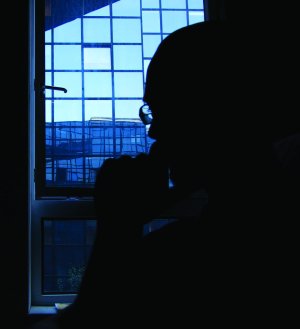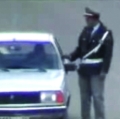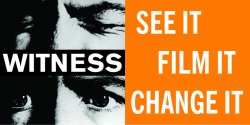TACTIC 2: VIDEO
SOMEONE IS WATCHING
witness and record
watch the full video
THIS TACTIC IS GOOD FOR ENSURING THAT PEOPLE HAVE THE POWER TO CAPTURE RIGHTS ABUSES AS THEY HAPPEN
EXAMPLES FROM THE VIDEO
|
|
Anonymous advocate in Morocco An advocate took video of police officers in Morocco repeatedly demanding bribes from motorists and published them on YouTube, where they were viewed hundreds of thousands of times. Not only did the government take action against the police officers, but it used the same technique as the “Targuist Sniper” by installing video cameras to catch police in the future.
TOOLS USED: Video camera, video editing software, YouTube, blogs.
LINKS TO LEARN MORE: |
|
|
Bloggers and advocates in Burma
TOOLS USED: Blogs, news reports, digital cameras, mobile phones, photos.
LINKS TO LEARN MORE: |
TACTIC 2: PLAN YOUR ACTION
SOMEONE IS WATCHING
witness and record
download this tactic card (pdf 1mb)

ANTONY TURBA (FLICKR)
Plan your action
- In Burma, bloggers and rights advocates faced significant risks in coming forward with their testimonies and evidence. How will you protect yourself and others involved in and supporting your campaign? Consider the digital trail you may leave: your IP address, email accounts, passwords, lists of friends you have on social network sites, the names that your mobile phones and SIM cards were purchased under, and the names and organisations that websites’ domain names have been registered to.
- Develop criteria for verifying the witness reports you collect and publish. Some citizen reporting platforms have been abused to accuse innocent people and expose dissidents’ identities.
- One way that WITNESS has protected the identities of people in video testimony is to not record their faces. By backlighting a person, you can record a silhouette of his or her face without showing revealing details. In this way, even if your tapes were seized, there would be no visual record of the people in them.
- Talk people through the “worst case scenario” if they told their story and their identity was compromised or revealed. This discussion allows you to get informed consent from people and can help you plan how to minimise risk.
Do it yourselfAsk
- Are you going to have time to plan how to collect witness testimonies? Or are you preparing advocates and supporters to spontaneously collect material in the most ethical and strategic way?
- What tools do people most impacted by your issues already have available to them to document rights abuses – mobile phones, digital cameras, access to social network sites and blogging?
- How can you respect the integrity of the people whose stories your campaign is sharing with a much broader audience?
- What is your media and outreach strategy? How will you respond to the press rapidly should your materials become part of a breaking news story?
- Who are you in relationship to the issue or community you are working with?
- How will you respond to requests for you to take down materials from your or others’ websites, either from governments, commercial web services, or people impacted by the images, videos, and blog posts?
Different ways you can do this
- You don’t need to use video. Ask people to use their mobile phones to send photos by email or if possible by multimedia message (MMS), which can later be made into a slideshow or published on their own.
- If it’s not possible to conceal people’s identities visually, you can use animation, puppetry, or photo montage as a way of digital storytelling.
- Being able to witness events fi rst-hand is rarely possible. You can reconstruct some events later through interviews, and by being introduced to people involved through trusted allies and contacts.
- Rather than recording the faces of people at live events, consider alternative, safer ways to get footage that will tell the story of an action or protest.
- For video intended to bring corruption to light, think about how you can explain clearly the roles of the people in it and their relationships to each other. By visually mapping these relationships you can highlight links between people, organisations, and corruption.
|
FEATURED TOOL A trusted video sharing community for human rights advocates |
TIPS VIOLETA KRASNIC, FROM WITNESS, ON CONCEALING IDENTITY: "Filming concealed identity interviews is a matter of trust, in people and in technology. Our consent process conveys the purpose of the video and its intended use in the video advocacy campaign and is built on an understanding of the security implications of the interview."
AUNG, BURMESE RIGHTS ADVOCATE, ON GETTING INFORMATION OUT: "The Saffron Revolution clearly indicated how citizen journalists are powerful for our country. Sometimes we bring information across the border using recording devices, and sometimes we use email or FTP – these are the sorts of methods we are using so far. Even though the regime has tried to shut down everything, bloggers and citizen journalists have been able to bring information to the outside media."
PRISCILLA NERI, FROM WITNESS, ON ETHICS AND PUBLICATION: "With so many questions unanswered in the video of Neda, I find myself without a good solution [for] what to do with it. What I know for sure is that it must be seen, and the young woman’s dignity must be respected. Perhaps this delicate balance can be achieved by blurring her identity in the video, or by thinking twice before selecting the image of her bloodied face as your new Facebook status." |
TACTIC 2: CASE STUDY
SOMEONE IS WATCHING
witness and record
download this tactic card (pdf 1mb)

ABCNT WWW.ABCNT.INFO
Case Study
| TITLE: WHO: WHERE: WEBSITE: |
Remembering Neda Advocates in Iran Tehran Death of Neda Agha-Soltan Wikipedia page |
DESCRIPTION
Two short videos showing the death of Neda Agha-Soltan during Iran’s post-election protests attained worldwide attention in June 2009. One video was shot by an anonymous man, and was then emailed to supporters and spread quickly to Facebook. The decision to email the video, rather than directly upload it, was made to protect the man who shot it, and also to circumvent the Iranian government’s censorship of the internet after the election. In addition, a second eyewitness video of Neda’s death appeared on CNN within hours of being uploaded to YouTube. Because the videos were posted and spread so quickly, there was little time to consider the implications of such a rapid spread of unedited, first-hand footage. Writing at WITNESS, Priscila Néri asks “As concerned citizens, activists, and fellow human beings, how do we balance the need to ‘spread the word’ of what’s unfolding in Iran with the need to respect Neda’s dignity as she dies, as well as the grief of her family faced with such tragedy?” As people’s ability to capture eye-witness reports and live events with mobile phones and digital cameras increases, the video footage of Neda challenges us to decide how to sensitively and strategically publicise these accounts, especially in volatile and high-pressure moments. It also illustrates the danger people can be put in when they post and re-post footage online: advocates and protesters have since been detained by the government in Iran, and Twitter and Facebook were named in trials against them.
| TOOLS USED: | Mobile phone cameras, email, YouTube, Twitter, Facebook, blogs. |
| REACH: | Hundreds of thousands to millions of people worldwide. |
| RESOURCES: | Access to data network on mobile phones and internet. |
| TIME: | A few hours, from the footage being shot to when it was uploaded. A few more hours before it was broadcast on international media. |
LEVEL Of DIFFICULTY: 2 out if 5
COST: N/A
LINKS TO LEARN MORE:
New York Times blog
Global Voices Neda webpage, Global Voices Victims of Protest webpage
WITNESS Hub video sharing website


